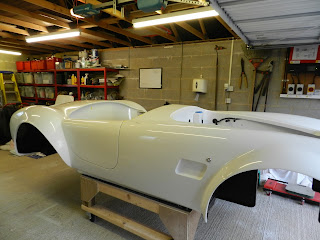Windscreen
Before I started any other work, I polished the scuttle with G6, then G3 Farecla compound so that I wouldn't catch the polishing bonnet on any new holes/slots.
The windscreen was fed in to the holes cut previously for the windscreen stanchions. This is a two person job as it is £500 + of kit and Mrs C helped here. The holes needed opening out a little to take the stanchions.
 |
| Starting to look like a car now with the windscreen fitted |
Demist slots
These may or may not be marked on the body by GD! Mine were not. I measured the ones on Keith Akerman's car, pre-marked by GD, to get the positions.
First I put some masking tape on the scuttle where the demist vent would go. The outer screw hole of each vent were positioned 220mm in from the windscreen mounting hole, 80mm back from the cockpit roll (measured at the centre line of the vent hole). The second hole was marked through the demist escutcheon. The end furthest from the windscreen stay was also positioned 80mm from the roll. I checked the measurements from a centre line just to be sure. I had used different measurements each side! Luckily I measured twice and cut once!
 |
| Centre line marked on the scuttle |
I drilled multiple holes in the scuttle and did the final cut with the trusty Dremel.
 |
| Demist vent with the escutcheon fitted |
The cut out edges of the demist slots were spray painted satin black, before the escutcheons were fitted and bolted though to the fish tail part of the demist vents (holes already tapped in the fish tail vents).
I also painted the side vents in the wings whilst I was on with it.
 |
| Off side dummy 'vent' painted in satin black |
Heater pipes
 |
| Fishtails can be seen mounted here under the scuttle |
Once these vents were cut, the escutcheons and fish tails fitted, the heater pipes were put in place. The heater pipes can be fitted to the heater as you wish, as both holes from the heater deliver warm air at the same rate. I took the hose from one hole to the centre of the transmission tunnel and cut it there. A 'Y' piece, made by Keith Akerman, was fitted here. Equal length hoses (to ensure equal volume of air gets to each vent) were then cut and connected from the 'Y' piece to the fish tail demist vents and secured with tie wraps.
 |
| Demist pipes in place |
A second hose was connected to the other outlet of the heater and again taken to the centre of the transmission tunnel. Here it was connected to the second 'Y' piece and equal length hoses (the supplied hose was not quite long enough) were attached, again using tie wraps to secure, for the foot well vents. I cut these pipes longer than it appeared necessary, so that the top part of each louvre vent could be attached to the under dash tray before fixing this in place.
Pedal box
Using a fly by wire pedal for the Chevy LS engine is not straight forward on the GD Cobra.
The fly by wire pedal cannot be used as it is, because there is insufficient space in the driver's foot well to use it as it is and its travel is not enough for a progressive pedal. Instead it needs to be adapted and mounted in the off side wheel arch compartment, at the other side of the driver's foot well. A bar is used to connect the electronic pedal to the accelerator pedal on the GD pedal box.
The GD pedal box was installed as normal, after drilling a 6mm hole in the accelerator pedal 10mm down the top part of the accelerator pedal and in-line with the pivot bar i.e. 90 deg to the pedal travel. This was a tricky job and require a drill stand and a drill clamp to hold the pedal - drilling a 6mm hole in a 10mm round bar was not easy! I used gradually bigger drill bits to make the hole.
A 20mm hole was then drilled through the bulkhead in line with the rose joint. I got this wrong the first time and will cover up my mistake with a bolt and washers to fill in the hole!
 |
| Bar attached to the accelerator pedal - correct hole marked! |
I kept the new hole near to the right side of the driver foot well, to allow the electronic pedal arm to remain as long as possible to maximise the leverage. I was aiming for 100mm of accelerator pedal travel. The electronic pedal only moves by about 55mm.
The foot plate on the electronic pedal was removed. The electronic pedal arm was shortened to fit in the compartment and a new hole drilled. However, I kept the arm as long as possible.
 |
| Pedal arm shortened and 6mm hole drilled |
The electronic pedal was then fixed
horizontally, above the brake and clutch master cylinders, to the bulkhead in the off side wheel arch compartment. Once fully adjusted and fixed in place I will post some photos.
The threaded bar has the two rose joints attached one at each end. Lock nuts are used to secure the rose joints in their final place. One end of the bar was fed through the hole in the bulkhead and attached to the accelerator pedal using a 6mm bolt through the rose joint and the other end was attached to the modified electronic pedal using another 6mm bolt through the other rose joint.



























